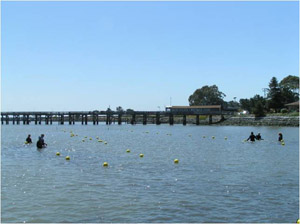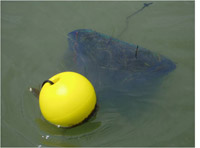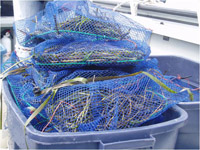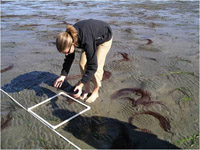Seeds of Innovation Bring New Life to
San Francisco Bay
Seven years ago, the San Francisco Bay was in trouble. Its eelgrass — an underwater plant critical to fish habitats — was disappearing due to 150 years of urban development around the bay.
The loss of the undersea vegetation has devastating consequences for a bay’s ecosystem: small fish have fewer places to hide from predators, and larger fish have less area in which to stalk their prey. Herring, for example, lose valuable plant beds on which to lay their eggs. Shoreline areas are at greater risk for erosion and water quality is reduced.
What San Francisco needed was an innovative way to restore the eelgrass. NOAA Fisheries’ Office of Habitat Conservation would lead the effort to find one.
In 2002, NOAA convened a series of workshops in San Francisco with eelgrass experts from across the country in hopes of a solution. Researchers Chris Pickerell, from Cornell University, and Sandy Wyllie-Echeverria, from the University of Washington’s Botanic Garden, brought with them an inventive way to grow eelgrass that they thought just might work: seed buoys.
From Fertile Minds Blooms New Eelgrass
Seed buoys are floatation devices with mesh bags of grass seeds attached. Anchored to various locations on the sea floor, seed buoys perform like flowering eelgrass plants, dispersing seeds as the water current moves the bag. Buoys are placed where soil conditions are optimal for the seeds to germinate into young plants.
The seed buoy is a relatively easy, low-tech way of growing eelgrass. The traditional method of planting eelgrass by hand into the bay’s floor — using scuba divers — can be expensive and labor intensive. And this method has not been very successful in San Francisco Bay.
Natalie Cosentino-Manning, a NOAA Fisheries’ biologist involved in the restoration effort, said that hand-planted eelgrass in the bay often “goes into shock” when exposed to new soil conditions and has difficulty taking root.
“It isn’t enough to just start plants, they need to survive and reproduce to be considered successful,” said Manning.
Testing the Waters
With funding from NOAA, bay restoration teams first conducted test trials with the seed buoys to see if the new method of growing eelgrass would work for San Francisco Bay as it had elsewhere (e.g., Sag Harbor Cove, NY, and the Chesapeake Bay).
Eelgrass seed buoys were deployed in three locations around the bay, with high success at two sites. The growth of new eelgrass plants in those sites has been stunning: seed buoys placed there in 2007 produced hundreds to thousands of new eelgrass shoots. Last year, the number of shoots had increased more than four-fold.
“This is really exciting,” added Manning. “Just a few years ago, people didn’t think there was enough eelgrass left in San Francisco Bay to try to restore it. Now we know so much more about eelgrass and how to bring it back.”
The seed buoy technique is being considered for areas of the bay damaged in 2008 from an oil spill caused by the cargo ship, Cosco Busan. Seed buoy pilot projects also have been proposed for locations in southern California.
Buoys as Beacons for Volunteerism
Beyond restoring valuable eelgrass beds, seed buoy restoration gives the public an opportunity to become more intimately involved in bay conservation.
For example, San Francisco’s Save the Bay volunteers help collect the ripening eelgrass seeds, assemble and position the seed buoys, and share in the joy of counting new plants.
“It’s really fun to wiggle out onto the mudflats at low tide and see the new shoots,” said Manning. “It is a real success story.”
To learn more about other NOAA habitat restoration projects, visit NOAA’s Marine Fisheries Service Web site.






![Podcast: Diving Deeper - Estuaries [MP3]](https://webarchive.library.unt.edu/eot2008/20090505233021im_/http://www.noaa.gov/features/resources_0509/images/estuary.jpg)



